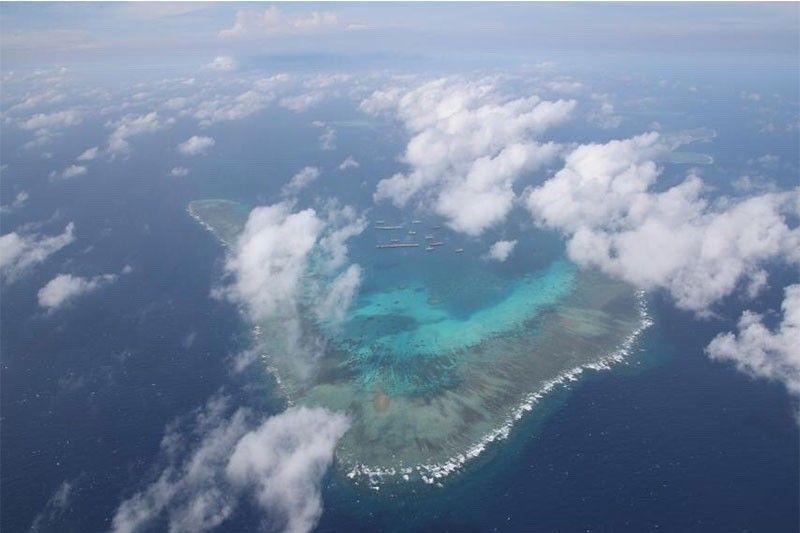China's gray zone operation in the making?: A commentary on Julian Felipe Reef crisis

On March 20, 2021, Department of National Defense Secretary Delfin Lorenzana officially informed the Filipino nation about the presence of around 220-blue hulled Chinese fishing vessels moored in line formation at Julian Felipe Reef (international name Whistin Reef). The reef is a wide boomerang-shaped shallow coral reef at the northeast of Pagkaisa Banks and Reefs (Union Reefs), located approximately 175 nautical miles west of Bataraza, Palawan.
According to him, the Philippine Coast Guard (PCG) sighted and reported the presence of around 220 Chinese fishing vessels, allegedly manned by the Chinese maritime militia, as early as March 7. The PCG reported its sighting to a relatively unknown interagency body, the National Task Forces for the West Philippine Sea (NTF-WPS).
The national security adviser, initially observed that these huge number of vessels might engage in “possible overfishing and destruction of the marine environment, as well as risks to safety of navigation.” Interestingly, however, the NTF-WPS changed its earlier observation when it noticed that the fishing vessels were believed to be manned by Chinese maritime militia personnel, and despite clear weather at the time, the Chinese fishing vessels showed no actual fishing activities and had their full white lights turned on all night. This generated doubts on their real purpose.
Lorenzana issued a statement calling on the “Chinese to stop this incursion and immediately recall these boats violating our maritime rights, and encroaching into our sovereign territory.” The statement also warned the Chinese that the Philippines is “committed to uphold its sovereign rights over the West Philippine Sea.”
The following day, Department of Foreign Affairs Secretary Teodoro Locsin filed a diplomatic protest with the Chinese Embassy in Manila. The embassy immediately rejected it, saying that the flotilla is not manned by the CMM but ordinary fishing vessels harboring in the reef to avoid inclement weather. It further added that, “Any speculation in such helps nothing but causes unnecessary irritations.”
The Chinese Foreign Ministry spokeswoman in Beijing reiterated their position that China’s fishing vessels have been staying near Whitsun Reef to shelter themselves from “strong winds”. However, the foreign ministry spokeswoman added a twist by calling Julian Felipe Reef with the Chinese name Niue Jiao; stating that Chinese fishermen have been fishing in the waters near the reef for a long period of time and claiming that it is part of the Spratly Islands and within their imaginary, U-shaped, nine-dash line, that claims 85% of the South China Sea.
Chinese gray zone operation
Since the end of the Cold War in the early 1990s, China has pressed its aggressive intrusions into the South China Sea where it has various territorial sovereignty disputes over maritime resources, and other issues with the littoral Southeast Asian states.
This led to incidents that had adverse effects on the security of two Southeast Asian states—a short but bloody skirmish with Vietnamese forces over the Spratly Islands in 1988, the establishment of a Chinese naval base on Mischief Reef in 1995 over which the Philippines claimed ownership, and the seizure of Scarborough Shoal in 2012, again at the expense of the Philippines.
These Chinese incursions into the South China Sea became possible because of the power vacuum in the strategic environment after the end of the Cold War. This was because the US pursued a policy of “disengagement” from Southeast Asia marked by the withdrawal of American forces from their military facilities in the Philippines.
These incursions also took the form of gray zone operations, which employs different combinations of influence, intimidation, coercion, deception, and veiled aggression to approach, probe, and at times, violate perceived unreadiness of the targeted state while skillfully remaining below the threshold of an outright military action.
China’s protracted approach to gray zone operation includes a healthy but dangerous mix of political, diplomatic, military and even economic/commercial instruments. These three instances of gray zone operations have enabled Beijing to contest and dominate these disputed spaces and achieved warlike aims without resorting to violence.
Gray zone operation in the making?
The gathering of a large number of Chinese fishing vessels in Julian Felipe Reef is currently seen by the Philippines as a prelude to gray zone operations like what happened in Mischief Reef in 1996, and again in Scarborough Shoal in 2012.
According to Simularity Inc., a US-based geospatial tech company, the Chinese fishing vessels have been anchored at the reef since December 2020. The satellite images show no fishing nor any significant movement.
They’ve just remained anchored and tied together at Julian Felipe Shoal. It was noted that although the number of ships in the reef varies on a day-to-day basis, the number of ships currently being observed is the same number seen anchored last December.
This behavior reflects the Chinese strategy of claiming submerged land features by swarming the disputed waters with a huge flotilla that effectively defy the other countries’ diplomatic or law enforcement efforts to expel it.
The goal is to accomplish by overwhelming presence what it has been unable to do through diplomacy, or economic statecraft or even the use of force— a classic gray zone operation.
Potentially, this build-up of Chinese fishing vessels in the Julian Felipe Reef will not only erode the Philippines’ control of the West Philippine Sea; it will also unravel the Duterte administration’s appeasement policy on China.
Renato Cruz de Castro is a trustee and convenor of the National Security and East Asian Affairs Program of think tank Stratbase ADR Institute.
- Latest































